Showing 111–120 of 134 results

The book presents the notion of unity in diversity in the context of globalization and multiculturalism. The concepts of unity and diversity have been contested in classical and modern theories. These theories give rise to the concept of diversity but jointly somehow they emerge as unity in diversity.
The book presents the notion of unity in diversity in the context of globalization and multiculturalism. Philosophically speaking, the concepts of unity and diversity have been contested in classical and modern theories; for instance, Plato’s idea of harmony and goodness, Aristotle’s phronesis or practical wisdom (teleology), Kant’s categorical imperative (deontology), and Mill’s utilitarianism (consequentialism) on the one hand and purusarthas divided into abhyudaya and nihsreyas, etc. on the other. These theories give rise to the concept of diversity but jointly somehow they emerge as unity in diversity.
In the era of globalization and multiculturalism, teleology, deontology, consequentialism and so on have been described, critiqued and even appreciated and appropriated from pluralistic perspective. With globalization and multiculturalism, human life is affected not only insofar as market is concerned, but also the ethnical, cultural and linguistic identities are equally affected. However, unlike globalization, multiculturalism endorses the role of the State in protecting and safeguarding the rights of diverse cultural groups, values and practices, marriage and settlements, property and inheritance, etc. so that members of each cultural community should become the valid participants in the civil and democratic life in the globalized world.
The perspectives of, and the conflict between individual needs and rights, and group needs and rights, have been conceptualized under liberalism and communitarianism. It is proposed to be achieved by developing cultural transformations in the era of globalization, thus creating reasonable exclusion on broader values. The effort is to allow these values to inform and reinforce each other for the possible foundations of multiculturalism, specially cosmopolitanism in the globalized world.

An anthology of over 90 articles penned by the renowned Sanskritists and Indologists in order to felicitate Prof. Vachaspati Upadhyaya covers different domains of Indian intellectual tradition, emphasizing upon the dialectical depth and thematic width of Indian philosophy, religions and culture enshrined in Sanskrit sources.
Vacaspativaibhavam is a modest tribute to the dynamic persona of Professor Vachaspati Upadhyaya whose chequered career spans more than four decades. In this volume, an earnest endeavour is made to collect and recollect his significant contribution to the academic world, both as a scholar as well as an administrator.
The first part of this volume carries benign blessings of saints and scholars for the unbound showering of divine grace upon Professor Upadhyaya. Many messages by the dignitaries and copious compliments from well-wishers and friends of Professor Upadhyaya convey his unmitigated commitment to the core human values cherished in his heart.
The second section of the volume comprises rich reminiscences penned by a vast majority of his colleagues and students from all over the country. These memoirs, in the form of personal reflections, are richly expressed through the medium of poetry and prose, and reveal the various aspects of the multifaceted personality of Professor Vachaspati Upadhyaya.
More than ninety research papers included in the principal part of the volume are not limited to the narrow compartmentalization of a particular subject but cover different domains of Indian intellectual tradition. Authored by a galaxy of scholars, Indian and foreign, these articles not only highlight the new ventures in cross-disciplinary studies, but also emphasize their basic concern with contemporary challenges facing humanity. The readers will relish that contributors to the volume have effectively reflected upon the dialectical depth and thematic width of Indian philosophy, religion and culture enshrined in Sanskrit sources.
In fine, the volume in hand promises to provide meaningful material for thought in the fields of Sanskrit and Indological Studies.
Vada, meaning debates, dialogues, discussions, was the quintessential of Indian spirit, enabling and promoting the growth of different philosophical and knowledge systems of India. It percolated deep into our mindset and enriched the moral, ethical, religious and sociocultural edifice of anything that was essentially Indian in nature. As continuation of Anvikshiki from the bc era, vada helped thrive Indian traditional knowledge systems. It subsists on diversity and its tradition envisages pluralism.
Most of our Sanskrit works, covering a wide gamut of knowledge systems, are structured in the techniques of debate. This reality applies not only to the philosophical writings, but to Indian medical systems (Ayurveda), Arthashastra of Kautilya and Kamasutra of Vatsyayana as well. Even great epics like Ramayana and Mahabharata are no exceptions.
Vada culture involved verbal duals, attacks and even violence of speech, and all major religious systems — old or modern — were parties to it. This book also elucidates how vata was vital and critical for the growth of our socio-political fabrics. It shows how some of the major conflicts in philosophical systems were centred around karma, jnana, choice between violence and non-violence, pravritti and nivritti. It also presents the manifestations of vada on a vast canvas during the nineteenth and twentieth centuries. Modern spiritual and religious gurus like Ramana Maharshi, J. Krishnamurti and Vinoba Bhave were men of dialogues. Our scholars have applied the varied techniques of vada against the philosophical and scientific systems of the West to prove them correct.
This collector’s issue should enthrall a wide audience of philosophers, scholars and believers in Indian knowledge systems.

This book reconsiders Valmiki Ramayana from different perspectives literary, aesthetic, ethical, comparative, interdisciplinary, religious, philosophical, social, and archaeological among others. In the process, it underscores significance of Ramayana from modern perspective, as it unveils its multilayered worlds.
Valmiki Ramayana, the first kavya (poetic composition) and the first mahakavya (epic) of the world, is an inexhaustible fountain of culture and knowledge. It has impacted infinite minds and souls in India and abroad, and continues to inspire and engage creative and critical minds, and will remain so for the ages to come.
Ramayana, along with standardizing Ramakatha, transcends history, geography and binaries of mode of thinking. Its appeal may be discerned from the fact that it exists in different versions in various regions and forms. Notwithstanding these versions, Valmiki Ramayana rules human heart and mind for its subject matter and manner of articulation.
The multilayered worlds of Ramayana make it a seedbed of ideas existing at various levels. Traversing generations, and getting interpreted anew in consonance with cultural needs and existential questions, it has earned serious critical consideration of scholars from different perspectives literary, aesthetic, ethical, comparative, interdisciplinary, religious, philosophical, moral, social, archaeological, and intermedial among many. Hence, it demands its reinterpretation by every generation. The present book is a testimony to it, and a response in this direction.
Consisting of scholarly papers by eminent intellectuals and with a perspicuous introduction, this book reconsiders Valmiki Ramayana from different perspectives, presented in a seminar on Ramayana that was organized with the blessings of Pujya Morari Bapu.
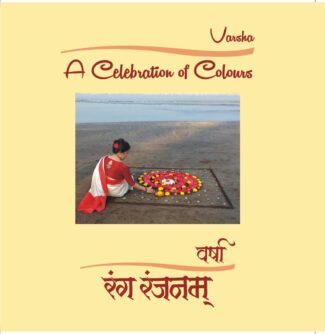
This volume, through colours, transcends many a cue of the aesthetic aspects of human life into a connoisseur’s mind. Whether on fabric or canvas, mud wall or floor, sculptures or pots, colours for us is a language, a raga and a tala.
Colours are not just for adornment, but a medium that reflects our state of mind, artistic acumen, culture, ethics, philosophy, social values, tradition and the sacredness of life. A non-verbal language, they conjure up our emotions, feelings and moo ds, and take a rasika far beyond the realms of words. In them we see the lush and luxuriant natural world around us, the world of birds and blossoms, earth and sky, gems and stones, creating in us a certain feeling and a gush of powerful ethos.
The artist in Varsha, through colours, transcends many a cue of the aesthetic aspects of human life into a connoisseurs mind. Whether on fabric or canvas, mud wall or floor, sculptures or pots, colours for us is a language, a raga and a tala. And Celebration of Colours is just that.
Involved with her family, Varsha loves art and craft, whether it is painting, embroidery, working with terracotta and ceramic, jewels and the creation of ornaments, crochet and knitting, stitching and designing clothes, or cooking. Absorbed in the world of colour, she likes to share her moment of beauty with everyone around her and spread joy everywhere.
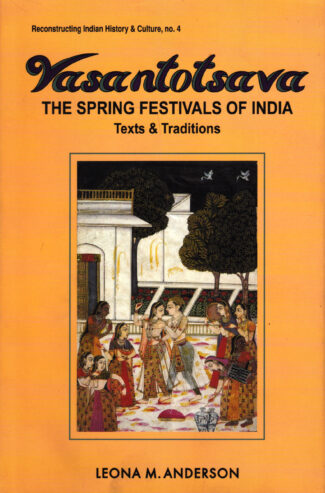
This study treats Vasantotsava as a thematically unified generic whole embracing a range of spring festivals, pansectarian in character and incorporating various rituals. It reassesses Sanskrit texts to explore the rituals, symbols and underlying motifs of the Vasantotsava.
This study treats Vasantotsava as a thematically unified generic whole embracing a wide range of spring festivals including the Phalgunotsava, Caitrotsava, Phalgu, Madhutsava, Madanamahotsava, Madanatroydashi, Anangotsava, Madanadvadaishi, Kamotsava, Shripancami, Yatramahotsava, and Holaka (Holi). These festivals are pansectarian in character and incorporate a variety of ritual observances practised through- out the Indian subcontinent. Signifying the termination of winter and announcing the advent of spring, the celebration was a diverse and complex spectacle situated within the framework of Indian ritual and myth. On the basis of puranic and ritual texts, folk tales, drama, poetry, and narratives in mixed prose and poetry (campus), Dr. Anderson addresses complex issues of indigenous ritual, mythology, and tradition. The Vasantotsava incorporates a broad spectrum of human concerns: in the sphere of polity, it can be turned to account to celebrate and reinforce the power of the king; in the social sphere, it is a time of revelry and merry-making indicative of the annual renewal in human affairs; and in the sphere of religion, it celebrates the exploits of the gods and establishes a link between human and divine actions and events.
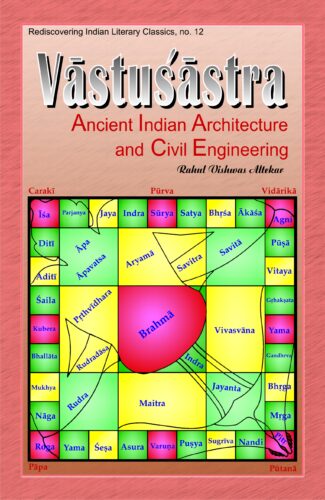
Examining vàstu÷àstra’s conceptual roots in øilpa÷àstra and its later evolution, the volume analyses technical aspects of vàstu÷àstra by concentrating on the essential elements (aïgas) of vàstu÷àstra which involve decision-making and actual construction methods, art of engineering and role and responsibilities of engineers, and aspects related to land materials and rituals associated with use of building after its construction
Though there has been considerable interest in vastushastra in recent times and the orientational aspects of vastushastra have been often discussed, little is known of the essential elements that constitute This small book, written in a simple and lucid style, contains teachings of great men, gleanings from the scriptures, and examples from the epics and Puranas, and suggests easy solutions to the various problems faced by man in the present-day world of violence, wars, killings and disasters, and how to have a holistic approach to life vastushastra and its scientific application in the present day. Based on extensive research, the work, vastushastra attempts to address this aspect. Examining comprehensively the subject of vastushastra: its conceptual roots in Shilpashastra and its later evolution as dealt with in the Vedas, the Epic literature, Arthashastra, literature on ayurveda and Kamasutra literature, the volume analyses technical aspects of vastushastra by concentrating on the essential elements [angas] of vastushastra which involve decision-making and actual construction methods, art of engineering and role and responsibilities of engineers, and aspects related to land materials and rituals associated with use of building after its construction. It discusses the eco-friendly life style of the ancient Indians based on vastushastra principles. Giving minute attention to details, it focuses on the application of vastushastra in the present-day society — how the vastushastra principles can be scientifically applied and the potential of application of vastushastra keeping in view modern trends in architectural science and civil engineering.
The book will be useful for students and scholars of architecture and engineering and those interested in vastushastra.
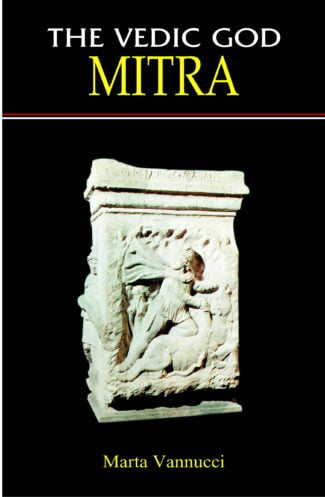
The book talks about the origin, personality and evolution of the Vedic God Mitra, and refers to the Rigveda and emergence of new gods as facets of the original Mitra-Mithra with time. It also delves into religious and cultural aspects of life associated with Him.
The Vedic God Mitra was highly revered and invoked for proper fulfilment of civil and religious acts and duties. Mentioned 175 times in the Rigveda alone, He has been described as one of the most wonderful, glorious and mighty of the Vedic gods.
This work presents a synthetic study of the evolution of the personality of Mitra, a most significant representative of the early stages of the ancient Indo-Aryan and Indo-Iranian cultures. Beginning with a discussion on the name and personality of the Vedic God, Mitra, the work deals with the evolution of the god by referring to the Rigveda and emergence of new gods as facets of the original Mitra-Mithra with time. It examines how the personality of Mitra evolved in tune with ecological and cultural diversification, growing complexity and increase in knowledge of the various groups of people who worshipped Mitra/Mithra. It delves into religious and cultural aspects of life associated with Him. It is a detailed study of the concept and origin of the Indo-Iranian God Mithra and the relationship of the god with others in the Avestan scheme of divinity.
The volume, with explanations of various terms and concepts and supported by illustrations, will be useful to scholars and students of Indology — in particular, ancient religion and culture in India.
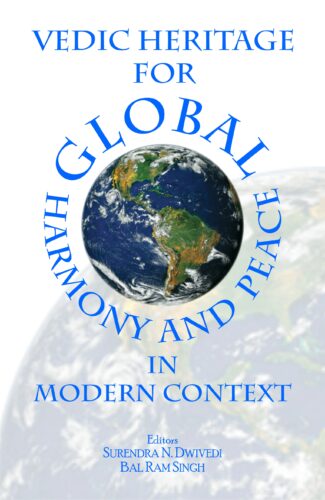
This volume delves into the different aspects of Vedic tradition, having global harmony and peace as the focus. It suggests one how to co-exist in the Upaniùads, how to practise Hindu universalism and the impact of âyurveda and the Bhagavad-Gita on our mental health, and the syncretism in ancient education.
The collection of scholarly articles presented in the volume explores various aspects of Vedic traditions, especially relating to global harmony and peace, in the present-day context. The Proceedings of the Sixth World Association for Vedic Studies (WAVES) Conference emphasise Vedic traditions as not confined to the Indian subcontinent today but as having spread to different parts of the globe. They deal with the essence of Vedanta, the contribution of the epic literature, history relating to the Rigvedic Aryans, Vedic sciences, and socio-economic and political aspects of Vedic life. Offering fresh ideas, they highlight the significance of the Vedic system for ensuring global peace and harmony, and satisfaction in the present. They study the concept of harmony and peace, and emphasise on the co-existence in the Upanishads, the Hindu concept of universalism, the importance of the Ayurveda and the Bhagavad-Gita in maintaining mental health, and on the global unity and syncretism in the education provided in ancient India. Attempts are made to cull out management ideas from the Mahabharata, and throw light on the relevance of the Arthashastra in modern-day geo-politics and the special relevance of Sanatana Dharma in the modern world. In the process, the scholars reveal the fictional aspects that have been linked to the Indian traditions and the related social evils.
The volume will interest a range of scholars of Indology and general readers as it explores the ancient Indian tradition, especially the Vedic tradition, in a comprehensive manner.

To resolve controversies related to Vedic Religion/Culture, the author comes to grips with the idea of Gods omnipresence in Aryan religious thought, the Rgvedic Hymn of Visvedevas, etc. and explores matters of historical and literary importance.
Despite two centuries of their multifarious, critical studies in India and the Western world, Vedic writings unveil myriad questions that have either baffled scholars or have led to serious controversies. A distinguished Indologist, Professor P.L. Bhargava marshals, for the first time, indisputable evidence to resolve some of these questions like, for instance: Who wrote the Rigvedic hymns? Which deities, in the Rigveda, constitute the group, called Adityas? Or, again in the Rigvedic contexts, what does the word asura mean? Who, of the two major Vedic gods: Indra and Varuna, has greater antiquity? Is Ayodhya: the birth place of Lord Rama, mentioned in the early Vedic literature? Where did Lord Ramas ancestors: the kings of Ikshvaku dynasty originally rule? And how far danastutis (the praises of gifts) of the Rigveda can help scholars to reconstruct the political history of the Vedic Age? Combining in him the erudition of a Sanskritist and a historian, the author also comes to grips with the idea of Gods omnipresence in Aryan religious thought, the enigmatic Hymn of Vishvedevas in the Rigveda, or the confounding words/phrases in its Hymn of Creation; besides several other issues of religious, cultural; historical and literary importance all these on the basis of his unbiased, life-long studies of the Vedic texts. An exquisite presentation of Dr Bhargavas writings, the volume covers a variety of themes that range from the very authorship of the Rigvedic hymns to the status of Vedic religion today. Invaluable to the scholars and specialists of Vedic lore.
| There are no products |